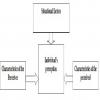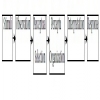Home | ARTS | Management Concepts & Organisational Behaviour
|
External Factors Influencing Selection - Perception And Learning
Management Concepts & Organisational Behaviour - Perception And Learning
External Factors Influencing Selection - Perception And Learning
Posted On :
The external factors influencing selection are nature, intensity, size, contrast, repetition, motion, and novelty and familiarity.
External Factors
Influencing Selection
The external factors influencing selection are nature, intensity, size, contrast, repetition, motion, and novelty and familiarity.
By this we try to understand the nature of the object. Is it a visual object? Does it have words, pictures, people or animals? Pictures attract attention more than words and a picture with human beings attracts attention more than a picture with inanimate objects. That is why cartoons and caricatures draw more attraction.
The intensity principle conveys that if the external stimulus is more intense in nature, the more it is likely to be perceived by the individual. That is why people pay more attention to loud noise, strong odour or bright light. At work places, superiors speak loudly to subordinates for this reason only.
Like intensity, size also matters very much. Larger objects are likely to be perceived more by the individuals than the smaller ones. A maintenance engineer gives greater attention to a bigger machine than a smaller one.
The contrast principle suggests that the external stimulus that stands out distinctly against the background or the one that is quite unusual will receive greater attention of the people.
The principle of repetition suggests that a repeated external stimulus draws more attention than a single one. The several advertisements of various products shown daily on TVs are based on the principle of repetition only. This principle also explains why supervisors have to give directions to workers repeatedly for even simple tasks.
According to this principle, people pay greater attention to moving objects rather than stationary objects. That is why advertisers create signs that incorporate moving parts.
The external factors influencing selection are nature, intensity, size, contrast, repetition, motion, and novelty and familiarity.
Nature
By this we try to understand the nature of the object. Is it a visual object? Does it have words, pictures, people or animals? Pictures attract attention more than words and a picture with human beings attracts attention more than a picture with inanimate objects. That is why cartoons and caricatures draw more attraction.
Intensity
The intensity principle conveys that if the external stimulus is more intense in nature, the more it is likely to be perceived by the individual. That is why people pay more attention to loud noise, strong odour or bright light. At work places, superiors speak loudly to subordinates for this reason only.
Size
Like intensity, size also matters very much. Larger objects are likely to be perceived more by the individuals than the smaller ones. A maintenance engineer gives greater attention to a bigger machine than a smaller one.
Contrast
The contrast principle suggests that the external stimulus that stands out distinctly against the background or the one that is quite unusual will receive greater attention of the people.
Repetition
The principle of repetition suggests that a repeated external stimulus draws more attention than a single one. The several advertisements of various products shown daily on TVs are based on the principle of repetition only. This principle also explains why supervisors have to give directions to workers repeatedly for even simple tasks.
Motion
According to this principle, people pay greater attention to moving objects rather than stationary objects. That is why advertisers create signs that incorporate moving parts.
Novelty and Familiarity
This principle states that either
a novel or a familiar external situation can better serve to draw attention.
New objects in familiar settings or familiar objects in new settings are likely
to draw the attention of the perceiver. Job rotation is followed in organizations
for this reason. For instance, workers will pay greater attention to the tasks
assigned to them in the new jobs in order to prove themselves and gain
acceptance in the new job.
Tags : Management Concepts & Organisational Behaviour - Perception And Learning
Last 30 days 843 views














